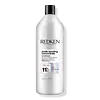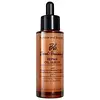What's inside
What's inside
 Key Ingredients
Key Ingredients

 Benefits
Benefits

 Concerns
Concerns

 Ingredients Side-by-side
Ingredients Side-by-side

Water
Skin ConditioningCetearyl Alcohol
EmollientGlycerin
HumectantBehentrimonium Chloride
PreservativeDimethicone
EmollientBis-Cetearyl Amodimethicone
Cetyl Esters
EmollientCitric Acid
BufferingIsopropyl Alcohol
SolventDicetyldimonium Chloride
EmulsifyingParfum
MaskingSodium Citrate
BufferingPhenoxyethanol
PreservativeCandelilla Cera
EmollientIsopropyl Myristate
EmollientHydroxypropyl Guar
Emulsion StabilisingLimonene
PerfumingCoco-Betaine
CleansingAmodimethicone
Cetrimonium Chloride
AntimicrobialDilauryl Thiodipropionate
AntioxidantTrideceth-10
CleansingSodium Chloride
MaskingLinalool
PerfumingPEG-100 Stearate
Citronellol
PerfumingSteareth-6
EmulsifyingTrideceth-3
EmulsifyingAcetic Acid
BufferingTrisodium Hedta
Water, Cetearyl Alcohol, Glycerin, Behentrimonium Chloride, Dimethicone, Bis-Cetearyl Amodimethicone, Cetyl Esters, Citric Acid, Isopropyl Alcohol, Dicetyldimonium Chloride, Parfum, Sodium Citrate, Phenoxyethanol, Candelilla Cera, Isopropyl Myristate, Hydroxypropyl Guar, Limonene, Coco-Betaine, Amodimethicone, Cetrimonium Chloride, Dilauryl Thiodipropionate, Trideceth-10, Sodium Chloride, Linalool, PEG-100 Stearate, Citronellol, Steareth-6, Trideceth-3, Acetic Acid, Trisodium Hedta
Water
Skin ConditioningPolysorbate 20
EmulsifyingGlycerin
HumectantPEG-40 Hydrogenated Castor Oil
EmulsifyingPropanediol
SolventOctyldodecyl Citrate Crosspolymer
HumectantHoney
HumectantYeast Extract
Skin ConditioningRaphanus Sativus Seed Extract
Skin ConditioningPyrus Malus Seed Oil
EmollientAleurites Moluccanus Seed Oil
Skin ConditioningHelianthus Annuus Seed Oil
EmollientGlycine Soja Seed Extract
Skin ConditioningHydrogenated Castor Oil/Sebacic Acid Copolymer
EmollientTocopherol
AntioxidantHydroxypropylgluconamide
HumectantHydroxypropylammonium Gluconate
HumectantDihydroxypropyl Arginine Hcl
HumectantPanthenol
Skin ConditioningPolyacrylate Crosspolymer-6
Emulsion StabilisingTartaric Acid
BufferingLinalool
PerfumingCitral
PerfumingLimonene
PerfumingBenzyl Alcohol
PerfumingT-Butyl Alcohol
PerfumingBenzyl Salicylate
PerfumingBenzyl Benzoate
AntimicrobialCaprylyl Glycol
EmollientButylene Glycol
HumectantCoumarin
PerfumingAscorbyl Palmitate
AntioxidantEthylhexyl Salicylate
UV AbsorberEthylhexyl Methoxycinnamate
UV AbsorberParfum
MaskingDisodium EDTA
BHT
AntioxidantPhenoxyethanol
PreservativePotassium Sorbate
PreservativeSodium Benzoate
MaskingWater, Polysorbate 20, Glycerin, PEG-40 Hydrogenated Castor Oil, Propanediol, Octyldodecyl Citrate Crosspolymer, Honey, Yeast Extract, Raphanus Sativus Seed Extract, Pyrus Malus Seed Oil, Aleurites Moluccanus Seed Oil, Helianthus Annuus Seed Oil, Glycine Soja Seed Extract, Hydrogenated Castor Oil/Sebacic Acid Copolymer, Tocopherol, Hydroxypropylgluconamide, Hydroxypropylammonium Gluconate, Dihydroxypropyl Arginine Hcl, Panthenol, Polyacrylate Crosspolymer-6, Tartaric Acid, Linalool, Citral, Limonene, Benzyl Alcohol, T-Butyl Alcohol, Benzyl Salicylate, Benzyl Benzoate, Caprylyl Glycol, Butylene Glycol, Coumarin, Ascorbyl Palmitate, Ethylhexyl Salicylate, Ethylhexyl Methoxycinnamate, Parfum, Disodium EDTA, BHT, Phenoxyethanol, Potassium Sorbate, Sodium Benzoate
 Reviews
Reviews

Ingredients Explained
These ingredients are found in both products.
Ingredients higher up in an ingredient list are typically present in a larger amount.
Glycerin is already naturally found in your skin. It helps moisturize and protect your skin.
A study from 2016 found glycerin to be more effective as a humectant than AHAs and hyaluronic acid.
As a humectant, it helps the skin stay hydrated by pulling moisture to your skin. The low molecular weight of glycerin allows it to pull moisture into the deeper layers of your skin.
Hydrated skin improves your skin barrier; Your skin barrier helps protect against irritants and bacteria.
Glycerin has also been found to have antimicrobial and antiviral properties. Due to these properties, glycerin is often used in wound and burn treatments.
In cosmetics, glycerin is usually derived from plants such as soybean or palm. However, it can also be sourced from animals, such as tallow or animal fat.
This ingredient is organic, colorless, odorless, and non-toxic.
Glycerin is the name for this ingredient in American English. British English uses Glycerol/Glycerine.
Learn more about GlycerinLimonene is a fragrance that adds scent and taste to a formulation.
It's found in the peel oil of citrus fruits and other plants such as lavender and eucalyptus. The scent of limonene is generally described as "sweet citrus".
Limonene acts as an antioxidant, meaning it helps neutralize free radicals.
When exposed to air, oxidized limonene may sensitize the skin. Because of this, limonene is often avoided by people with sensitive skin.
The term 'fragrance' is not regulated in many countries. In many cases, it is up to the brand to define this term. For instance, many brands choose to label themselves as "fragrance-free" because they are not using synthetic fragrances. However, their products may still contain ingredients such as essential oils that are considered a fragrance.
Learn more about LimoneneLinalool is a fragrance and helps add scent to products. It's derived from common plants such as cinnamon, mint, citrus, and lavender.
Like Limonene, this ingredient oxidizes when exposed to air. Oxidized linalool can cause allergies and skin sensitivity.
This ingredient has a scent that is floral, spicy tropical, and citrus-like.
Learn more about LinaloolParfum is a catch-all term for an ingredient or more that is used to give a scent to products.
Also called "fragrance", this ingredient can be a blend of hundreds of chemicals or plant oils. This means every product with "fragrance" or "parfum" in the ingredients list is a different mixture.
For instance, Habanolide is a proprietary trade name for a specific aroma chemical. When used as a fragrance ingredient in cosmetics, most aroma chemicals fall under the broad labeling category of “FRAGRANCE” or “PARFUM” according to EU and US regulations.
The term 'parfum' or 'fragrance' is not regulated in many countries. In many cases, it is up to the brand to define this term.
For instance, many brands choose to label themselves as "fragrance-free" because they are not using synthetic fragrances. However, their products may still contain ingredients such as essential oils that are considered a fragrance by INCI standards.
One example is Calendula flower extract. Calendula is an essential oil that still imparts a scent or 'fragrance'.
Depending on the blend, the ingredients in the mixture can cause allergies and sensitivities on the skin. Some ingredients that are known EU allergens include linalool and citronellol.
Parfum can also be used to mask or cover an unpleasant scent.
The bottom line is: not all fragrances/parfum/ingredients are created equally. If you are worried about fragrances, we recommend taking a closer look at an ingredient. And of course, we always recommend speaking with a professional.
Learn more about ParfumPhenoxyethanol is a preservative that has germicide, antimicrobial, and aromatic properties. Studies show that phenoxyethanol can prevent microbial growth. By itself, it has a scent that is similar to that of a rose.
It's often used in formulations along with Caprylyl Glycol to preserve the shelf life of products.
Water. It's the most common cosmetic ingredient of all. You'll usually see it at the top of ingredient lists, meaning that it makes up the largest part of the product.
So why is it so popular? Water most often acts as a solvent - this means that it helps dissolve other ingredients into the formulation.
You'll also recognize water as that liquid we all need to stay alive. If you see this, drink a glass of water. Stay hydrated!
Learn more about Water